NEWS
Kalmykia Marks the Sacred White Month with Buddhist Rituals and Exhibition
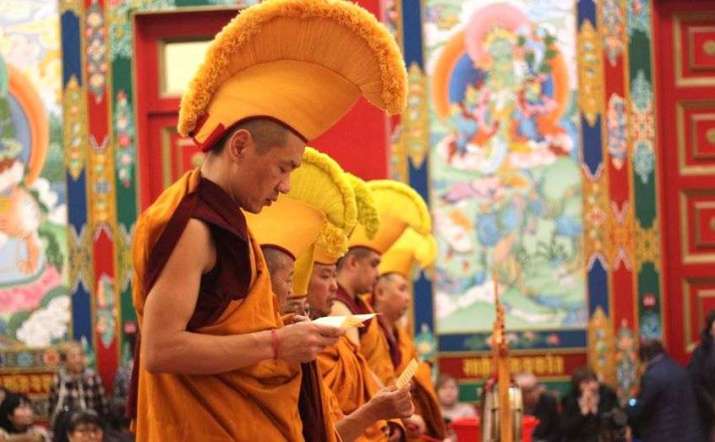 Kalmyk monks lead prayers at the Golden Abode of Shakyamuni Buddha. From khurul.ru
Kalmyk monks lead prayers at the Golden Abode of Shakyamuni Buddha. From khurul.ruOn 24 February, the first day of the sacred “White Month,” an ancient ritual and an exhibition dedicated to the Fifteen Miracles of Shakyamuni Buddha were organized at the Central khurul (temple) of the Russian republic of Kalmykia, the Golden Abode of Shakyamuni Buddha.
White Month, the first month of the Lunar New Year, is celebrated across the southern Siberian steppe, Mongolia, and in large regions of China. Known as Tsagaan Sar in Mongolia and Kalmykia, Sagaalgaan in Buryatia, and Shagaa in Tuva, it is one of the most important holidays in the region and coincides with the Tibetan New Year (Losar).
In Kalmykia, Tsagaan Sar is observed as a holiday of spring and is associated with the female Buddhist deity Okon Tengri*—patron of all Kalmyk people. According to local legends (domog), Okon Tengri saved the world from her son, born from her marriage to the king of the mangus (monsters). According to the tale, by turning into a giant, the baby could eventually destroy the entire human race. The goddess descended to Earth during Tsagaan Sar, blessing living beings, especially those who observe morality and accumulate spiritual merit.
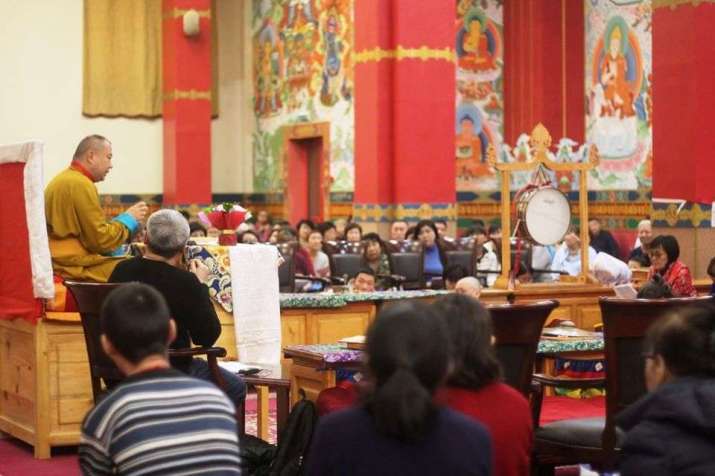 Telo Tulku Rinpoche during the Tsagaan Sar celebration. From khurul.ru
Telo Tulku Rinpoche during the Tsagaan Sar celebration. From khurul.ru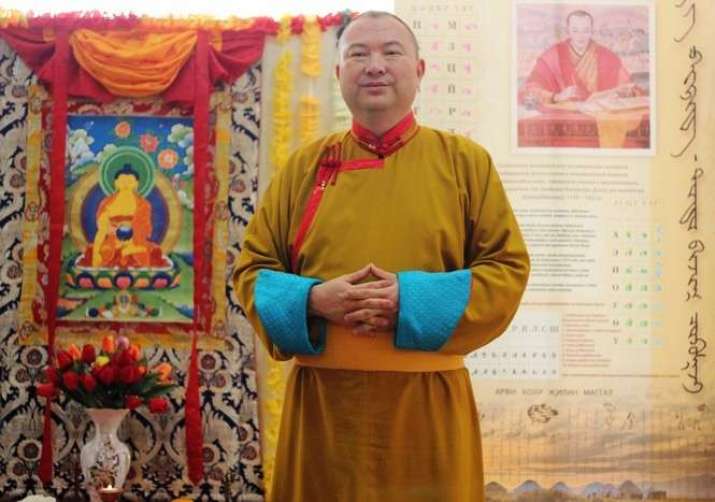 Telo Tulku Rinpoche. From khurul.r
Telo Tulku Rinpoche. From khurul.rOn the first day of Tsagaan Sar, a special ritual was held at the Central khurul, with offerings of prayers and torma (ritual cakes) to the deity Okon Tengri. During the annual ceremony, the Kalmyk monks express gratitude to their patron and pay respect to the Buddha’s teachings. The ritual started with greetings from Telo Tulku Rinpoche, the Shajin (Supreme) Lama of Kalmykia and the honorary representative of His Holiness the Dalai Lama in Russia, Mongolia, and the Commonwealth of Independent States. Rinpoche presented the meaning of Tsagaan Sar for the Kalmyks: “This bright holiday symbolizes the arrival of spring, the awakening of nature, the renewal of life, and the hope for a beautiful future. It has been preserved since time immemorial, as it embodies the best traditions and customs of the Kalmyk people. It embodies our spiritual values, our faith, and our aspiration for the future.” (Золотая обитель Будды Шакьямуни).
The heads of all regions of Kalmykia attended the celebration of Tsagaan Sar and received statues of the bodhisattva Kshitigarbha from the Shajin Lama. The ceremony continued with chanting of the famous Kalmyk prayer “Baazr Dari,” which was distributed to all attendees in the hall, along with the image and the prayer of Okon Tengri.
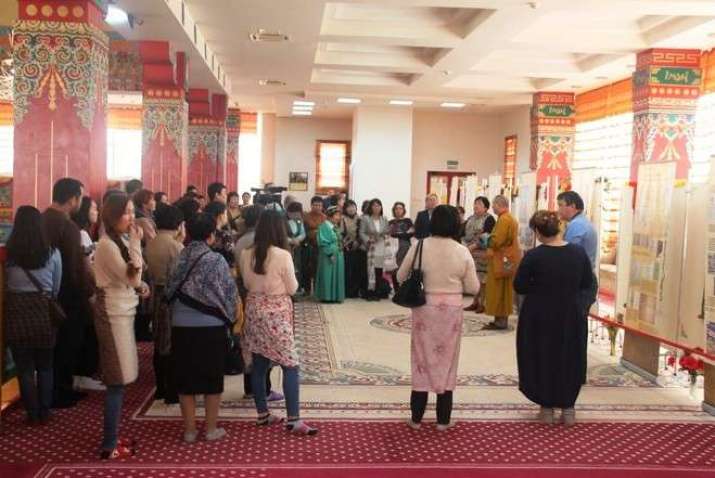 The opening of the exhibition, Fifteen Miracles of Shakyamuni Buddha. From khurul.ru
The opening of the exhibition, Fifteen Miracles of Shakyamuni Buddha. From khurul.ru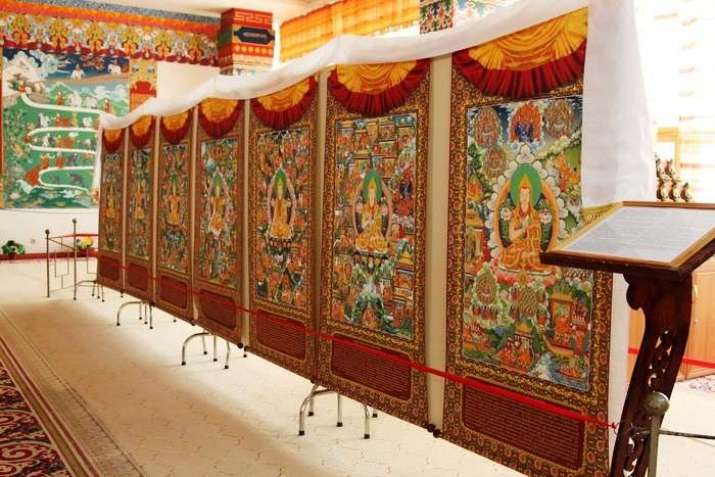 Thangkas depicting the life and work of Je Tsongkhapa. From khurul.ru
Thangkas depicting the life and work of Je Tsongkhapa. From khurul.ruAfter the ceremony, the opening of the exhibition Fifteen Miracles of Shakyamuni Buddha was held on the third floor of the khurul, in the presence Telo Tulku Rinpoche. The exhibition was organized by the National Museum of the Republic of Kalmykia, named after N. N. Palmov, and the Golden Abode of Shakyamuni Buddha. It presents the miraculous acts of Shakyamuni performed in the first 15 days of the Lunar New Year in the Indian city of Shravasti during a dispute with the preachers of six false teachings. During these auspicious days, the Great Prayer Festival (Tib. Monlam Chenmo) is performed at Buddhist temples in Tibet, Mongolia, and the Buddhist republics of Russia.
The exhibition includes 15 Tibetan thangkas, presenting the life and work of the great Tibetan teacher Je Tsongkhapa (1357–1419), founder of Gelug school of Tibetan Buddhism, who is known in Kalmykia as Zunkva Geghyan. The thangkas were donated to the Kalmyk temple by the office of His Holiness the Dalai Lama.
* Okon Tengri is the Kalmyk version of Palden Lhamo (Glorious Goddess), a Tibetan form of the ancient Indian goddess Shridevi. Her cult was introduced in Tibet around the 10th century, and from 16th century onward, she became associated with the protection of Lhasa and of the Dalai Lama. She serves as dharmapala (protector of the Buddhist faith) and is revered as a wrathful emanation of the goddess Sarasvati.
** Kshitigarbha (Tib: Sa Yi Nyingpo) is one of the eight great bodhisattvas (Tib. Nyewe Se Gye), whose activity focuses more particularly on helping those who suffer in the hell realms.
See more
Открытие выставки «15 чудес Будды Шакьямуни»
Traditions of the celebration of Tsagan Sar among Kalmyks
Related news from Buddhistdoor Global
International Buddhist Conference in Kalmykia Marks the 420th Birth Anniversary of Zaya Pandita
Lama Zopa Rinpoche Visits Moscow and Kalmykia
Dudjom Yangsi Rinpoche Visits Moscow and Kalmykia
Related features from Buddhistdoor Global
New Maitreya Statue Consecrated in Kalmykia
Cultural Autonomy and Spiritual Revival in Kalmykia: A Conversation with Valeriya Gazizova
The Dalai Lama’s Visits to Kalmykia














